Business Communication Strategies: A Report on the M&S Environment
VerifiedAdded on 2020/07/22
|10
|3091
|42
Report
AI Summary
This report delves into the multifaceted realm of business communication, using Mark and Spencer as a case study. It begins by analyzing the communication needs of both internal and external stakeholders, highlighting the differences in communication styles and objectives. The report then explores various communication models, such as the Shannon and Weaver and Schramm's models, and evaluates the effectiveness of different communication systems including email and face-to-face interactions. Factors influencing the choice of communication media are discussed, along with the importance of correct grammar, punctuation, and structure in business communications. The report also addresses overcoming communication barriers, using communication theories and body language, and proofreading techniques. Furthermore, it examines the purpose and audience of communication, appropriate media choices, and the significance of business practices in written communication. The report also includes a discussion on effective language use, non-verbal communication, and the importance of meeting deadlines in a business context.
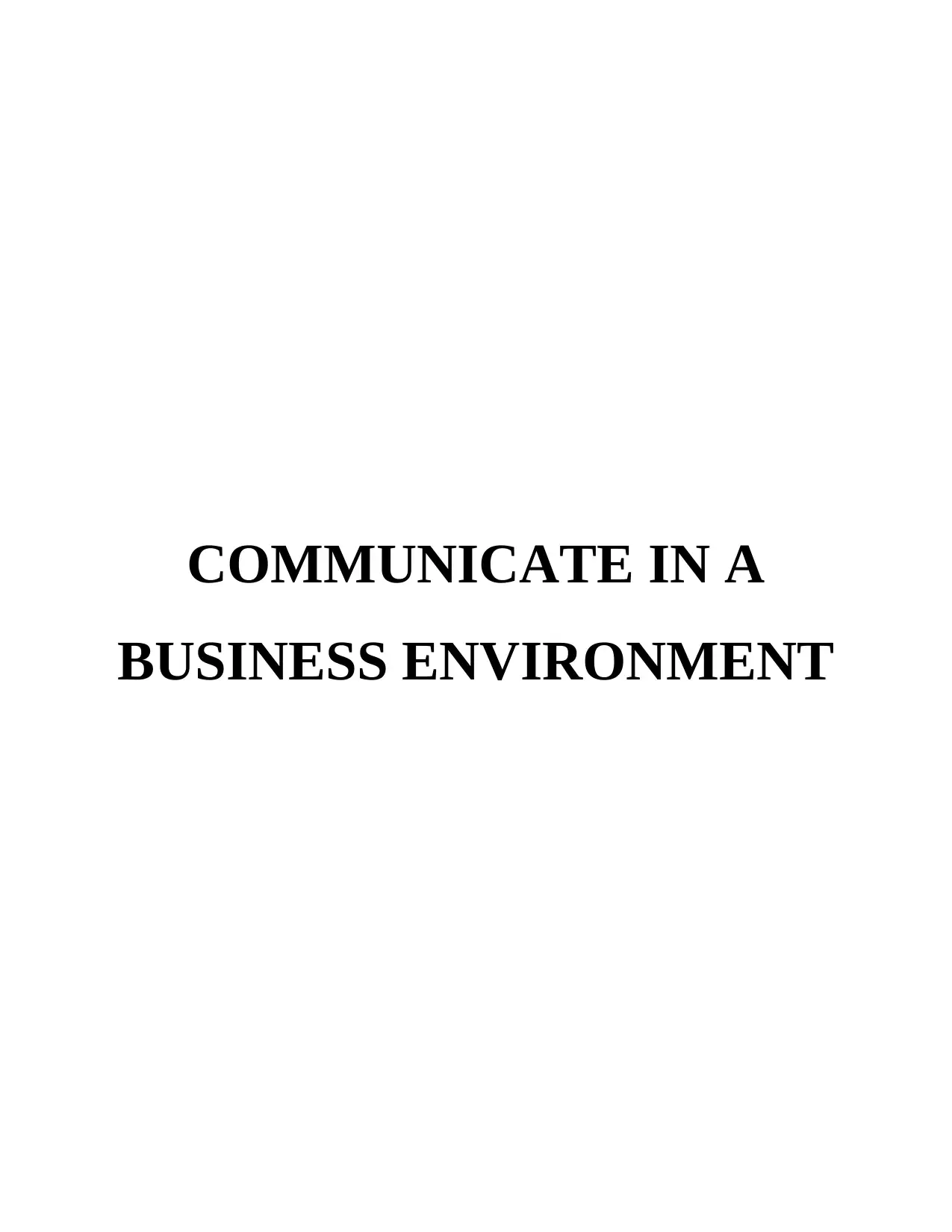
COMMUNICATE IN A
BUSINESS ENVIRONMENT
BUSINESS ENVIRONMENT
Paraphrase This Document
Need a fresh take? Get an instant paraphrase of this document with our AI Paraphraser
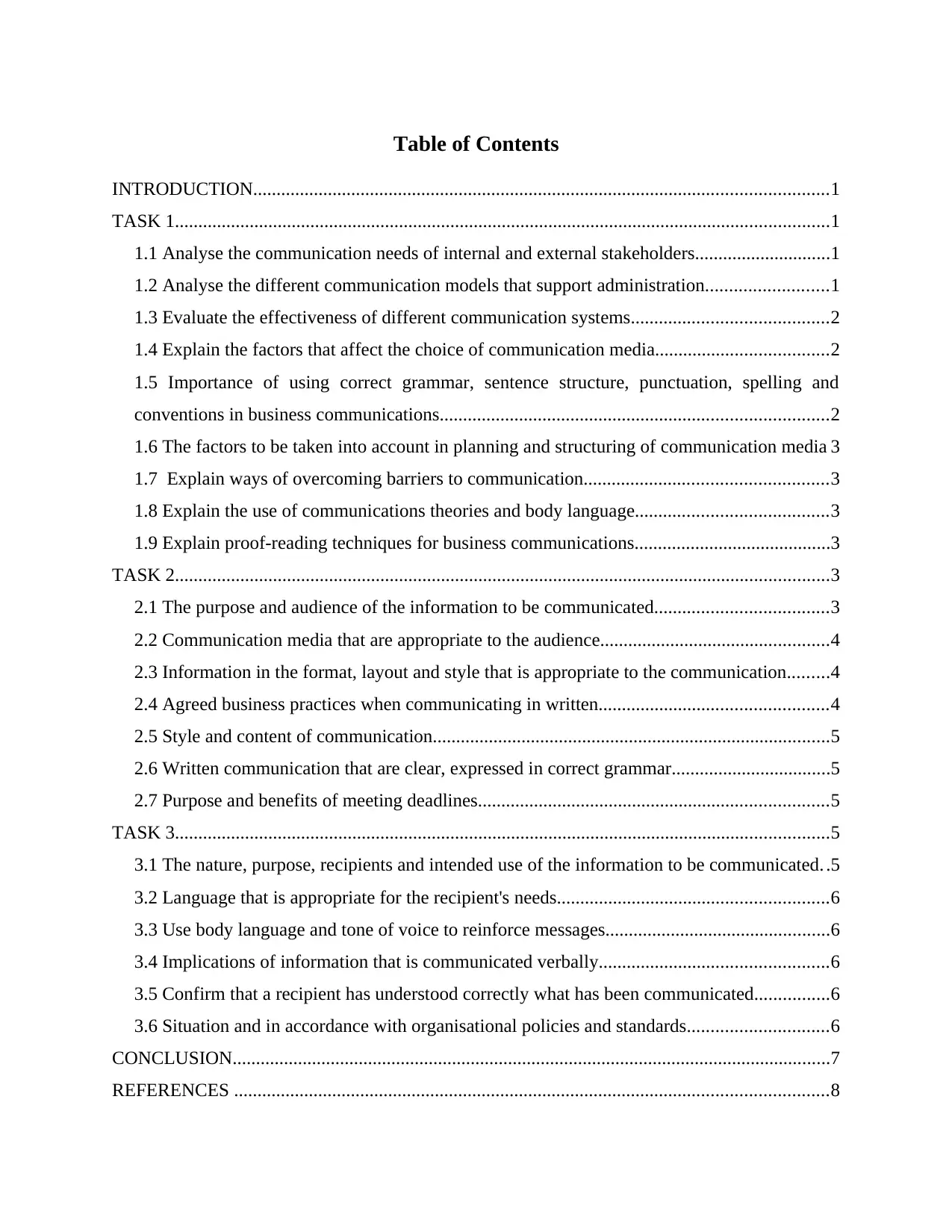
Table of Contents
INTRODUCTION...........................................................................................................................1
TASK 1............................................................................................................................................1
1.1 Analyse the communication needs of internal and external stakeholders.............................1
1.2 Analyse the different communication models that support administration..........................1
1.3 Evaluate the effectiveness of different communication systems..........................................2
1.4 Explain the factors that affect the choice of communication media.....................................2
1.5 Importance of using correct grammar, sentence structure, punctuation, spelling and
conventions in business communications...................................................................................2
1.6 The factors to be taken into account in planning and structuring of communication media 3
1.7 Explain ways of overcoming barriers to communication....................................................3
1.8 Explain the use of communications theories and body language.........................................3
1.9 Explain proof-reading techniques for business communications..........................................3
TASK 2............................................................................................................................................3
2.1 The purpose and audience of the information to be communicated.....................................3
2.2 Communication media that are appropriate to the audience.................................................4
2.3 Information in the format, layout and style that is appropriate to the communication.........4
2.4 Agreed business practices when communicating in written.................................................4
2.5 Style and content of communication.....................................................................................5
2.6 Written communication that are clear, expressed in correct grammar..................................5
2.7 Purpose and benefits of meeting deadlines...........................................................................5
TASK 3............................................................................................................................................5
3.1 The nature, purpose, recipients and intended use of the information to be communicated. .5
3.2 Language that is appropriate for the recipient's needs..........................................................6
3.3 Use body language and tone of voice to reinforce messages................................................6
3.4 Implications of information that is communicated verbally.................................................6
3.5 Confirm that a recipient has understood correctly what has been communicated................6
3.6 Situation and in accordance with organisational policies and standards..............................6
CONCLUSION................................................................................................................................7
REFERENCES ...............................................................................................................................8
INTRODUCTION...........................................................................................................................1
TASK 1............................................................................................................................................1
1.1 Analyse the communication needs of internal and external stakeholders.............................1
1.2 Analyse the different communication models that support administration..........................1
1.3 Evaluate the effectiveness of different communication systems..........................................2
1.4 Explain the factors that affect the choice of communication media.....................................2
1.5 Importance of using correct grammar, sentence structure, punctuation, spelling and
conventions in business communications...................................................................................2
1.6 The factors to be taken into account in planning and structuring of communication media 3
1.7 Explain ways of overcoming barriers to communication....................................................3
1.8 Explain the use of communications theories and body language.........................................3
1.9 Explain proof-reading techniques for business communications..........................................3
TASK 2............................................................................................................................................3
2.1 The purpose and audience of the information to be communicated.....................................3
2.2 Communication media that are appropriate to the audience.................................................4
2.3 Information in the format, layout and style that is appropriate to the communication.........4
2.4 Agreed business practices when communicating in written.................................................4
2.5 Style and content of communication.....................................................................................5
2.6 Written communication that are clear, expressed in correct grammar..................................5
2.7 Purpose and benefits of meeting deadlines...........................................................................5
TASK 3............................................................................................................................................5
3.1 The nature, purpose, recipients and intended use of the information to be communicated. .5
3.2 Language that is appropriate for the recipient's needs..........................................................6
3.3 Use body language and tone of voice to reinforce messages................................................6
3.4 Implications of information that is communicated verbally.................................................6
3.5 Confirm that a recipient has understood correctly what has been communicated................6
3.6 Situation and in accordance with organisational policies and standards..............................6
CONCLUSION................................................................................................................................7
REFERENCES ...............................................................................................................................8
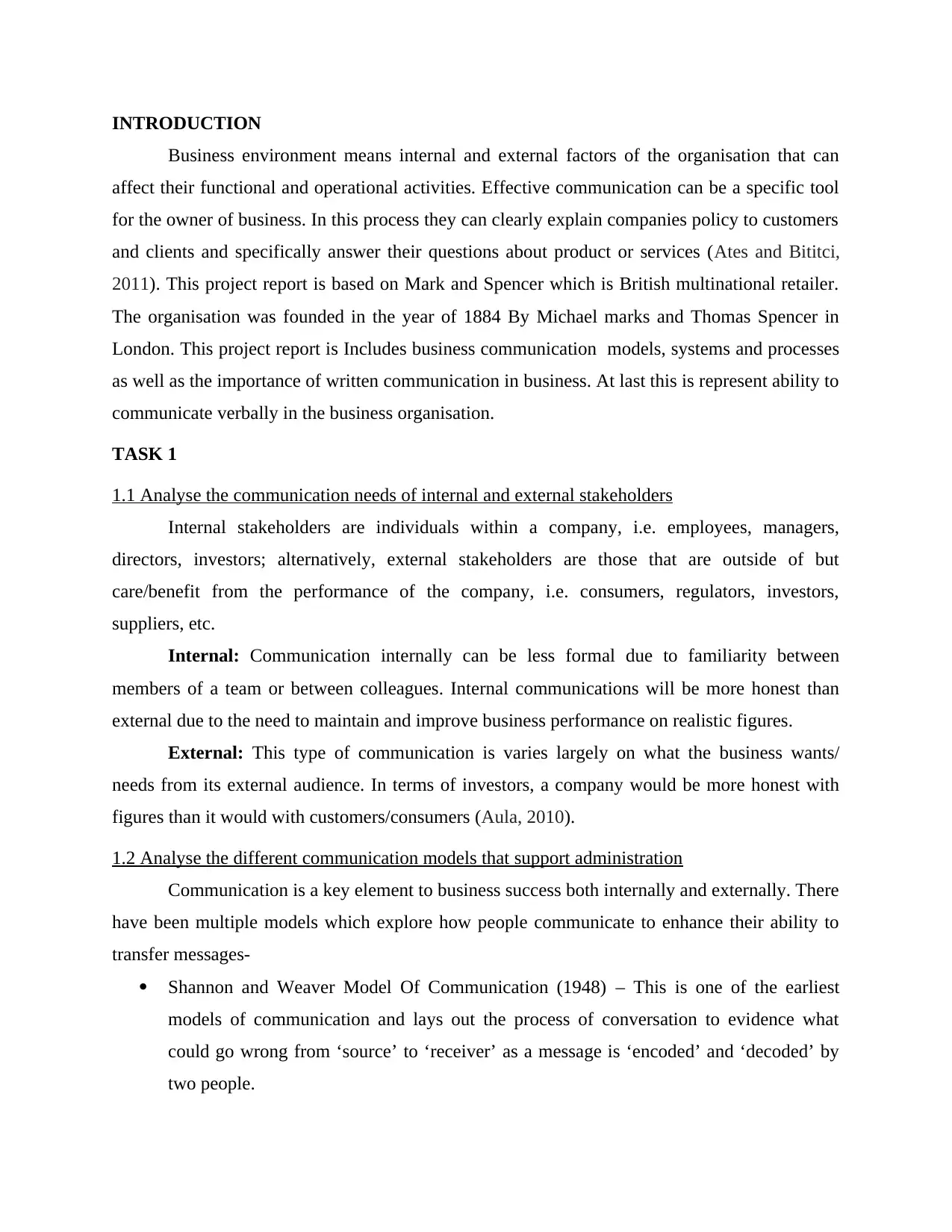
INTRODUCTION
Business environment means internal and external factors of the organisation that can
affect their functional and operational activities. Effective communication can be a specific tool
for the owner of business. In this process they can clearly explain companies policy to customers
and clients and specifically answer their questions about product or services (Ates and Bititci,
2011). This project report is based on Mark and Spencer which is British multinational retailer.
The organisation was founded in the year of 1884 By Michael marks and Thomas Spencer in
London. This project report is Includes business communication models, systems and processes
as well as the importance of written communication in business. At last this is represent ability to
communicate verbally in the business organisation.
TASK 1
1.1 Analyse the communication needs of internal and external stakeholders
Internal stakeholders are individuals within a company, i.e. employees, managers,
directors, investors; alternatively, external stakeholders are those that are outside of but
care/benefit from the performance of the company, i.e. consumers, regulators, investors,
suppliers, etc.
Internal: Communication internally can be less formal due to familiarity between
members of a team or between colleagues. Internal communications will be more honest than
external due to the need to maintain and improve business performance on realistic figures.
External: This type of communication is varies largely on what the business wants/
needs from its external audience. In terms of investors, a company would be more honest with
figures than it would with customers/consumers (Aula, 2010).
1.2 Analyse the different communication models that support administration
Communication is a key element to business success both internally and externally. There
have been multiple models which explore how people communicate to enhance their ability to
transfer messages-
Shannon and Weaver Model Of Communication (1948) – This is one of the earliest
models of communication and lays out the process of conversation to evidence what
could go wrong from ‘source’ to ‘receiver’ as a message is ‘encoded’ and ‘decoded’ by
two people.
Business environment means internal and external factors of the organisation that can
affect their functional and operational activities. Effective communication can be a specific tool
for the owner of business. In this process they can clearly explain companies policy to customers
and clients and specifically answer their questions about product or services (Ates and Bititci,
2011). This project report is based on Mark and Spencer which is British multinational retailer.
The organisation was founded in the year of 1884 By Michael marks and Thomas Spencer in
London. This project report is Includes business communication models, systems and processes
as well as the importance of written communication in business. At last this is represent ability to
communicate verbally in the business organisation.
TASK 1
1.1 Analyse the communication needs of internal and external stakeholders
Internal stakeholders are individuals within a company, i.e. employees, managers,
directors, investors; alternatively, external stakeholders are those that are outside of but
care/benefit from the performance of the company, i.e. consumers, regulators, investors,
suppliers, etc.
Internal: Communication internally can be less formal due to familiarity between
members of a team or between colleagues. Internal communications will be more honest than
external due to the need to maintain and improve business performance on realistic figures.
External: This type of communication is varies largely on what the business wants/
needs from its external audience. In terms of investors, a company would be more honest with
figures than it would with customers/consumers (Aula, 2010).
1.2 Analyse the different communication models that support administration
Communication is a key element to business success both internally and externally. There
have been multiple models which explore how people communicate to enhance their ability to
transfer messages-
Shannon and Weaver Model Of Communication (1948) – This is one of the earliest
models of communication and lays out the process of conversation to evidence what
could go wrong from ‘source’ to ‘receiver’ as a message is ‘encoded’ and ‘decoded’ by
two people.
⊘ This is a preview!⊘
Do you want full access?
Subscribe today to unlock all pages.

Trusted by 1+ million students worldwide
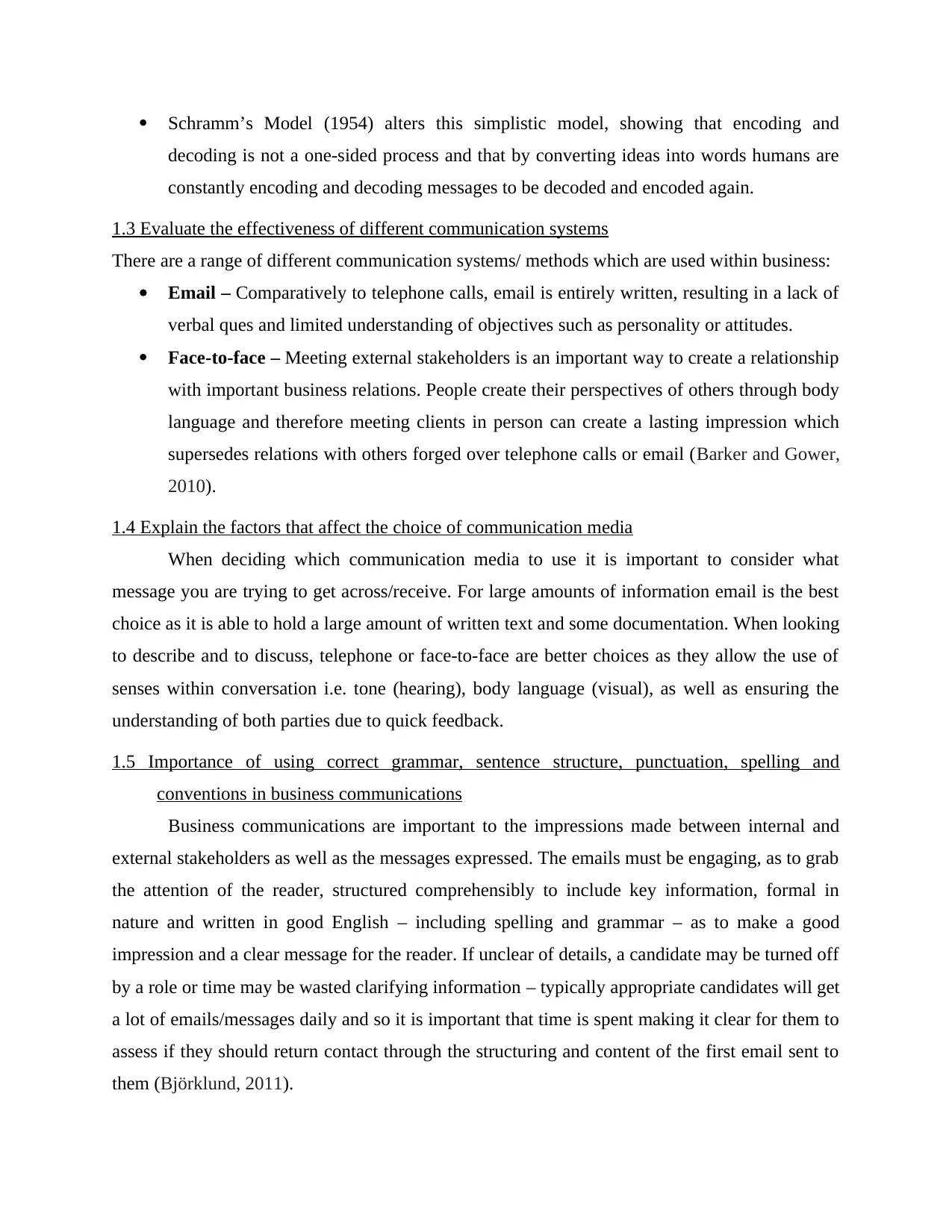
Schramm’s Model (1954) alters this simplistic model, showing that encoding and
decoding is not a one-sided process and that by converting ideas into words humans are
constantly encoding and decoding messages to be decoded and encoded again.
1.3 Evaluate the effectiveness of different communication systems
There are a range of different communication systems/ methods which are used within business:
Email – Comparatively to telephone calls, email is entirely written, resulting in a lack of
verbal ques and limited understanding of objectives such as personality or attitudes.
Face-to-face – Meeting external stakeholders is an important way to create a relationship
with important business relations. People create their perspectives of others through body
language and therefore meeting clients in person can create a lasting impression which
supersedes relations with others forged over telephone calls or email (Barker and Gower,
2010).
1.4 Explain the factors that affect the choice of communication media
When deciding which communication media to use it is important to consider what
message you are trying to get across/receive. For large amounts of information email is the best
choice as it is able to hold a large amount of written text and some documentation. When looking
to describe and to discuss, telephone or face-to-face are better choices as they allow the use of
senses within conversation i.e. tone (hearing), body language (visual), as well as ensuring the
understanding of both parties due to quick feedback.
1.5 Importance of using correct grammar, sentence structure, punctuation, spelling and
conventions in business communications
Business communications are important to the impressions made between internal and
external stakeholders as well as the messages expressed. The emails must be engaging, as to grab
the attention of the reader, structured comprehensibly to include key information, formal in
nature and written in good English – including spelling and grammar – as to make a good
impression and a clear message for the reader. If unclear of details, a candidate may be turned off
by a role or time may be wasted clarifying information – typically appropriate candidates will get
a lot of emails/messages daily and so it is important that time is spent making it clear for them to
assess if they should return contact through the structuring and content of the first email sent to
them (Björklund, 2011).
decoding is not a one-sided process and that by converting ideas into words humans are
constantly encoding and decoding messages to be decoded and encoded again.
1.3 Evaluate the effectiveness of different communication systems
There are a range of different communication systems/ methods which are used within business:
Email – Comparatively to telephone calls, email is entirely written, resulting in a lack of
verbal ques and limited understanding of objectives such as personality or attitudes.
Face-to-face – Meeting external stakeholders is an important way to create a relationship
with important business relations. People create their perspectives of others through body
language and therefore meeting clients in person can create a lasting impression which
supersedes relations with others forged over telephone calls or email (Barker and Gower,
2010).
1.4 Explain the factors that affect the choice of communication media
When deciding which communication media to use it is important to consider what
message you are trying to get across/receive. For large amounts of information email is the best
choice as it is able to hold a large amount of written text and some documentation. When looking
to describe and to discuss, telephone or face-to-face are better choices as they allow the use of
senses within conversation i.e. tone (hearing), body language (visual), as well as ensuring the
understanding of both parties due to quick feedback.
1.5 Importance of using correct grammar, sentence structure, punctuation, spelling and
conventions in business communications
Business communications are important to the impressions made between internal and
external stakeholders as well as the messages expressed. The emails must be engaging, as to grab
the attention of the reader, structured comprehensibly to include key information, formal in
nature and written in good English – including spelling and grammar – as to make a good
impression and a clear message for the reader. If unclear of details, a candidate may be turned off
by a role or time may be wasted clarifying information – typically appropriate candidates will get
a lot of emails/messages daily and so it is important that time is spent making it clear for them to
assess if they should return contact through the structuring and content of the first email sent to
them (Björklund, 2011).
Paraphrase This Document
Need a fresh take? Get an instant paraphrase of this document with our AI Paraphraser
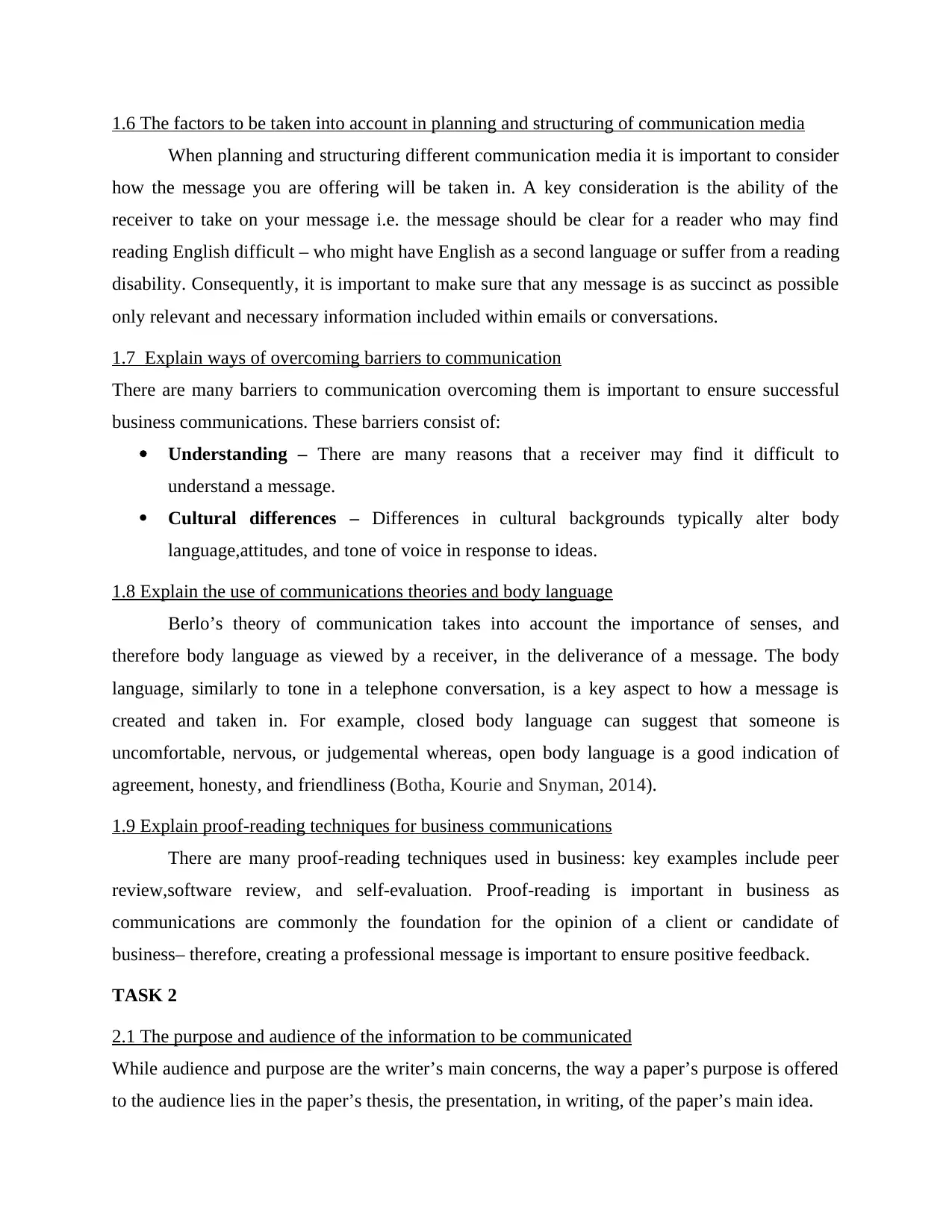
1.6 The factors to be taken into account in planning and structuring of communication media
When planning and structuring different communication media it is important to consider
how the message you are offering will be taken in. A key consideration is the ability of the
receiver to take on your message i.e. the message should be clear for a reader who may find
reading English difficult – who might have English as a second language or suffer from a reading
disability. Consequently, it is important to make sure that any message is as succinct as possible
only relevant and necessary information included within emails or conversations.
1.7 Explain ways of overcoming barriers to communication
There are many barriers to communication overcoming them is important to ensure successful
business communications. These barriers consist of:
Understanding – There are many reasons that a receiver may find it difficult to
understand a message.
Cultural differences – Differences in cultural backgrounds typically alter body
language,attitudes, and tone of voice in response to ideas.
1.8 Explain the use of communications theories and body language
Berlo’s theory of communication takes into account the importance of senses, and
therefore body language as viewed by a receiver, in the deliverance of a message. The body
language, similarly to tone in a telephone conversation, is a key aspect to how a message is
created and taken in. For example, closed body language can suggest that someone is
uncomfortable, nervous, or judgemental whereas, open body language is a good indication of
agreement, honesty, and friendliness (Botha, Kourie and Snyman, 2014).
1.9 Explain proof-reading techniques for business communications
There are many proof-reading techniques used in business: key examples include peer
review,software review, and self-evaluation. Proof-reading is important in business as
communications are commonly the foundation for the opinion of a client or candidate of
business– therefore, creating a professional message is important to ensure positive feedback.
TASK 2
2.1 The purpose and audience of the information to be communicated
While audience and purpose are the writer’s main concerns, the way a paper’s purpose is offered
to the audience lies in the paper’s thesis, the presentation, in writing, of the paper’s main idea.
When planning and structuring different communication media it is important to consider
how the message you are offering will be taken in. A key consideration is the ability of the
receiver to take on your message i.e. the message should be clear for a reader who may find
reading English difficult – who might have English as a second language or suffer from a reading
disability. Consequently, it is important to make sure that any message is as succinct as possible
only relevant and necessary information included within emails or conversations.
1.7 Explain ways of overcoming barriers to communication
There are many barriers to communication overcoming them is important to ensure successful
business communications. These barriers consist of:
Understanding – There are many reasons that a receiver may find it difficult to
understand a message.
Cultural differences – Differences in cultural backgrounds typically alter body
language,attitudes, and tone of voice in response to ideas.
1.8 Explain the use of communications theories and body language
Berlo’s theory of communication takes into account the importance of senses, and
therefore body language as viewed by a receiver, in the deliverance of a message. The body
language, similarly to tone in a telephone conversation, is a key aspect to how a message is
created and taken in. For example, closed body language can suggest that someone is
uncomfortable, nervous, or judgemental whereas, open body language is a good indication of
agreement, honesty, and friendliness (Botha, Kourie and Snyman, 2014).
1.9 Explain proof-reading techniques for business communications
There are many proof-reading techniques used in business: key examples include peer
review,software review, and self-evaluation. Proof-reading is important in business as
communications are commonly the foundation for the opinion of a client or candidate of
business– therefore, creating a professional message is important to ensure positive feedback.
TASK 2
2.1 The purpose and audience of the information to be communicated
While audience and purpose are the writer’s main concerns, the way a paper’s purpose is offered
to the audience lies in the paper’s thesis, the presentation, in writing, of the paper’s main idea.
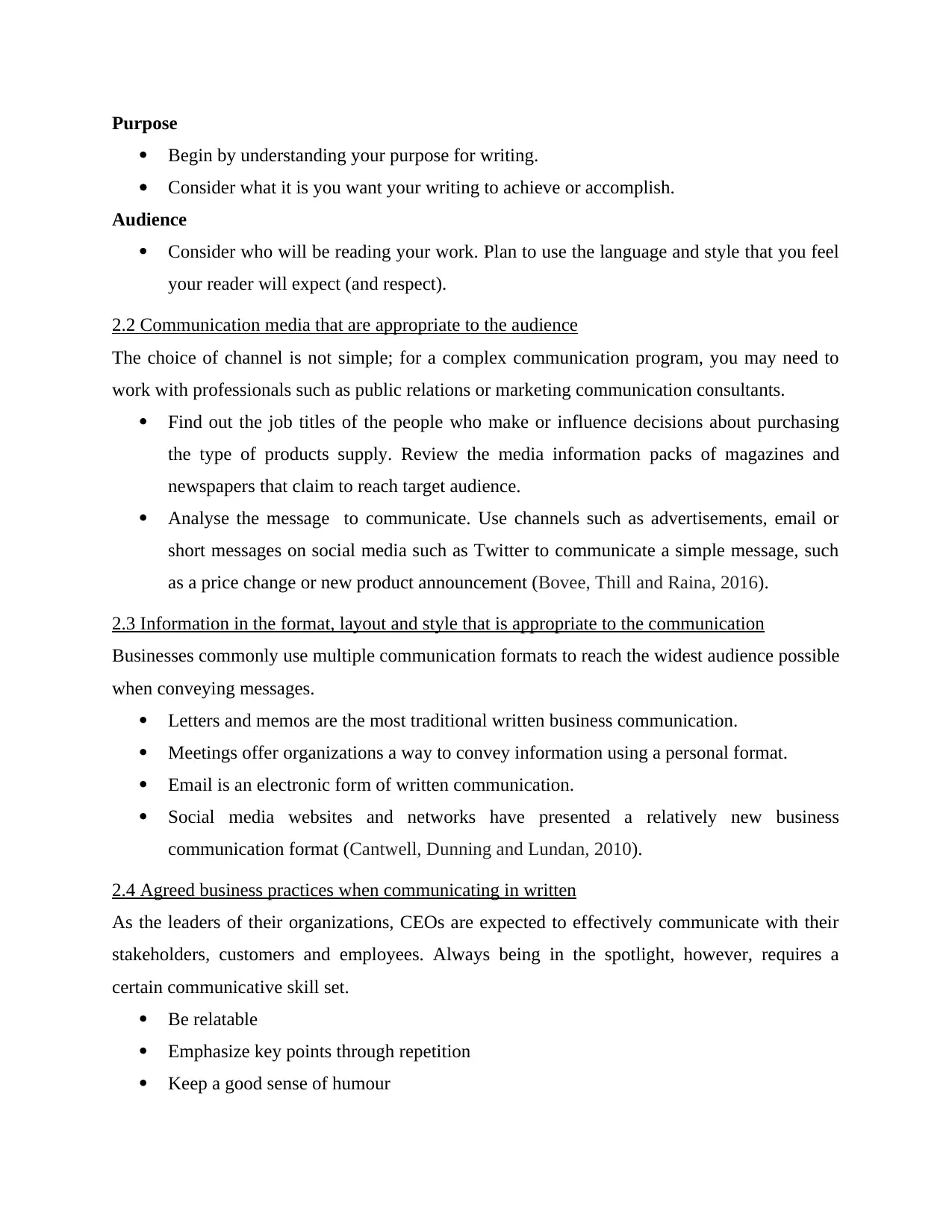
Purpose
Begin by understanding your purpose for writing.
Consider what it is you want your writing to achieve or accomplish.
Audience
Consider who will be reading your work. Plan to use the language and style that you feel
your reader will expect (and respect).
2.2 Communication media that are appropriate to the audience
The choice of channel is not simple; for a complex communication program, you may need to
work with professionals such as public relations or marketing communication consultants.
Find out the job titles of the people who make or influence decisions about purchasing
the type of products supply. Review the media information packs of magazines and
newspapers that claim to reach target audience.
Analyse the message to communicate. Use channels such as advertisements, email or
short messages on social media such as Twitter to communicate a simple message, such
as a price change or new product announcement (Bovee, Thill and Raina, 2016).
2.3 Information in the format, layout and style that is appropriate to the communication
Businesses commonly use multiple communication formats to reach the widest audience possible
when conveying messages.
Letters and memos are the most traditional written business communication.
Meetings offer organizations a way to convey information using a personal format.
Email is an electronic form of written communication.
Social media websites and networks have presented a relatively new business
communication format (Cantwell, Dunning and Lundan, 2010).
2.4 Agreed business practices when communicating in written
As the leaders of their organizations, CEOs are expected to effectively communicate with their
stakeholders, customers and employees. Always being in the spotlight, however, requires a
certain communicative skill set.
Be relatable
Emphasize key points through repetition
Keep a good sense of humour
Begin by understanding your purpose for writing.
Consider what it is you want your writing to achieve or accomplish.
Audience
Consider who will be reading your work. Plan to use the language and style that you feel
your reader will expect (and respect).
2.2 Communication media that are appropriate to the audience
The choice of channel is not simple; for a complex communication program, you may need to
work with professionals such as public relations or marketing communication consultants.
Find out the job titles of the people who make or influence decisions about purchasing
the type of products supply. Review the media information packs of magazines and
newspapers that claim to reach target audience.
Analyse the message to communicate. Use channels such as advertisements, email or
short messages on social media such as Twitter to communicate a simple message, such
as a price change or new product announcement (Bovee, Thill and Raina, 2016).
2.3 Information in the format, layout and style that is appropriate to the communication
Businesses commonly use multiple communication formats to reach the widest audience possible
when conveying messages.
Letters and memos are the most traditional written business communication.
Meetings offer organizations a way to convey information using a personal format.
Email is an electronic form of written communication.
Social media websites and networks have presented a relatively new business
communication format (Cantwell, Dunning and Lundan, 2010).
2.4 Agreed business practices when communicating in written
As the leaders of their organizations, CEOs are expected to effectively communicate with their
stakeholders, customers and employees. Always being in the spotlight, however, requires a
certain communicative skill set.
Be relatable
Emphasize key points through repetition
Keep a good sense of humour
⊘ This is a preview!⊘
Do you want full access?
Subscribe today to unlock all pages.

Trusted by 1+ million students worldwide
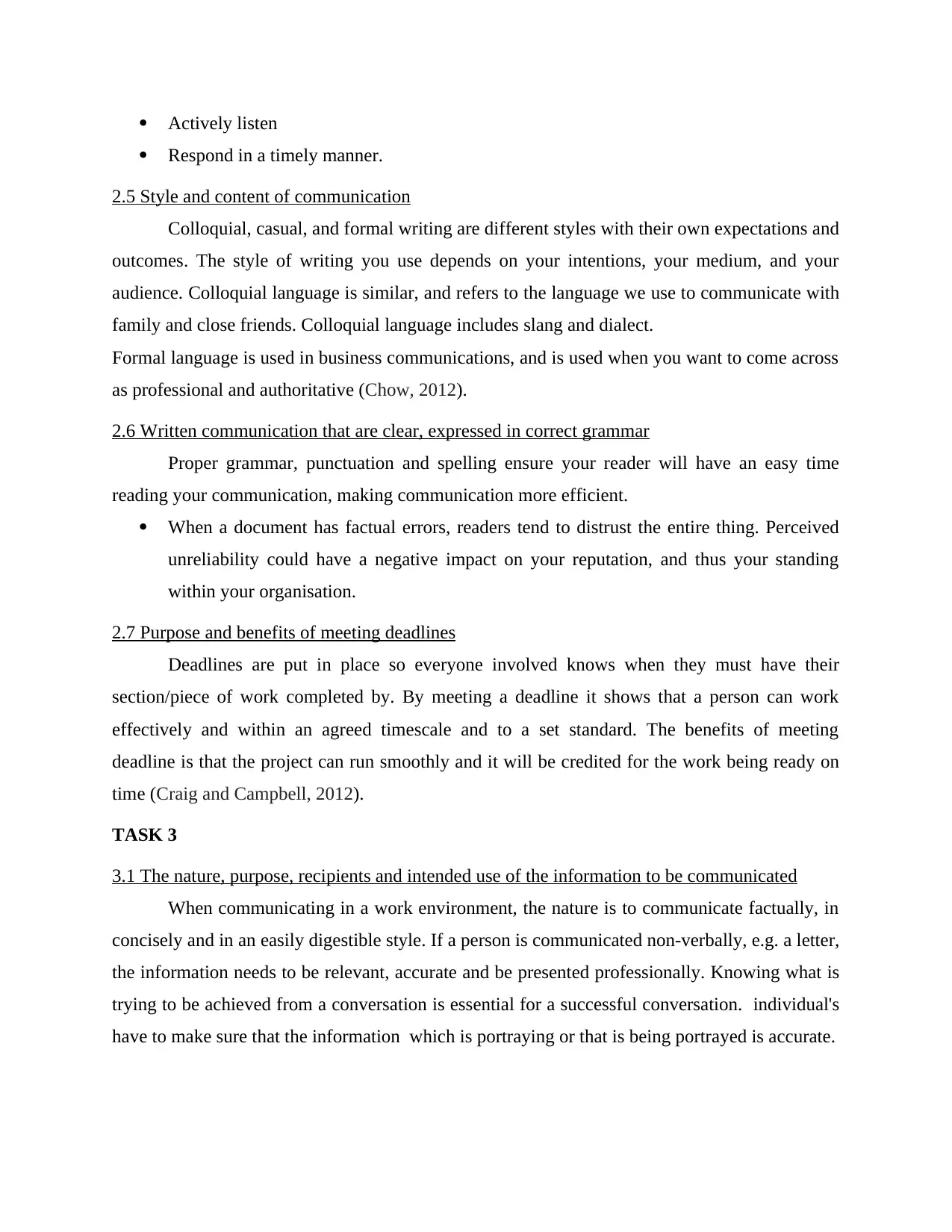
Actively listen
Respond in a timely manner.
2.5 Style and content of communication
Colloquial, casual, and formal writing are different styles with their own expectations and
outcomes. The style of writing you use depends on your intentions, your medium, and your
audience. Colloquial language is similar, and refers to the language we use to communicate with
family and close friends. Colloquial language includes slang and dialect.
Formal language is used in business communications, and is used when you want to come across
as professional and authoritative (Chow, 2012).
2.6 Written communication that are clear, expressed in correct grammar
Proper grammar, punctuation and spelling ensure your reader will have an easy time
reading your communication, making communication more efficient.
When a document has factual errors, readers tend to distrust the entire thing. Perceived
unreliability could have a negative impact on your reputation, and thus your standing
within your organisation.
2.7 Purpose and benefits of meeting deadlines
Deadlines are put in place so everyone involved knows when they must have their
section/piece of work completed by. By meeting a deadline it shows that a person can work
effectively and within an agreed timescale and to a set standard. The benefits of meeting
deadline is that the project can run smoothly and it will be credited for the work being ready on
time (Craig and Campbell, 2012).
TASK 3
3.1 The nature, purpose, recipients and intended use of the information to be communicated
When communicating in a work environment, the nature is to communicate factually, in
concisely and in an easily digestible style. If a person is communicated non-verbally, e.g. a letter,
the information needs to be relevant, accurate and be presented professionally. Knowing what is
trying to be achieved from a conversation is essential for a successful conversation. individual's
have to make sure that the information which is portraying or that is being portrayed is accurate.
Respond in a timely manner.
2.5 Style and content of communication
Colloquial, casual, and formal writing are different styles with their own expectations and
outcomes. The style of writing you use depends on your intentions, your medium, and your
audience. Colloquial language is similar, and refers to the language we use to communicate with
family and close friends. Colloquial language includes slang and dialect.
Formal language is used in business communications, and is used when you want to come across
as professional and authoritative (Chow, 2012).
2.6 Written communication that are clear, expressed in correct grammar
Proper grammar, punctuation and spelling ensure your reader will have an easy time
reading your communication, making communication more efficient.
When a document has factual errors, readers tend to distrust the entire thing. Perceived
unreliability could have a negative impact on your reputation, and thus your standing
within your organisation.
2.7 Purpose and benefits of meeting deadlines
Deadlines are put in place so everyone involved knows when they must have their
section/piece of work completed by. By meeting a deadline it shows that a person can work
effectively and within an agreed timescale and to a set standard. The benefits of meeting
deadline is that the project can run smoothly and it will be credited for the work being ready on
time (Craig and Campbell, 2012).
TASK 3
3.1 The nature, purpose, recipients and intended use of the information to be communicated
When communicating in a work environment, the nature is to communicate factually, in
concisely and in an easily digestible style. If a person is communicated non-verbally, e.g. a letter,
the information needs to be relevant, accurate and be presented professionally. Knowing what is
trying to be achieved from a conversation is essential for a successful conversation. individual's
have to make sure that the information which is portraying or that is being portrayed is accurate.
Paraphrase This Document
Need a fresh take? Get an instant paraphrase of this document with our AI Paraphraser
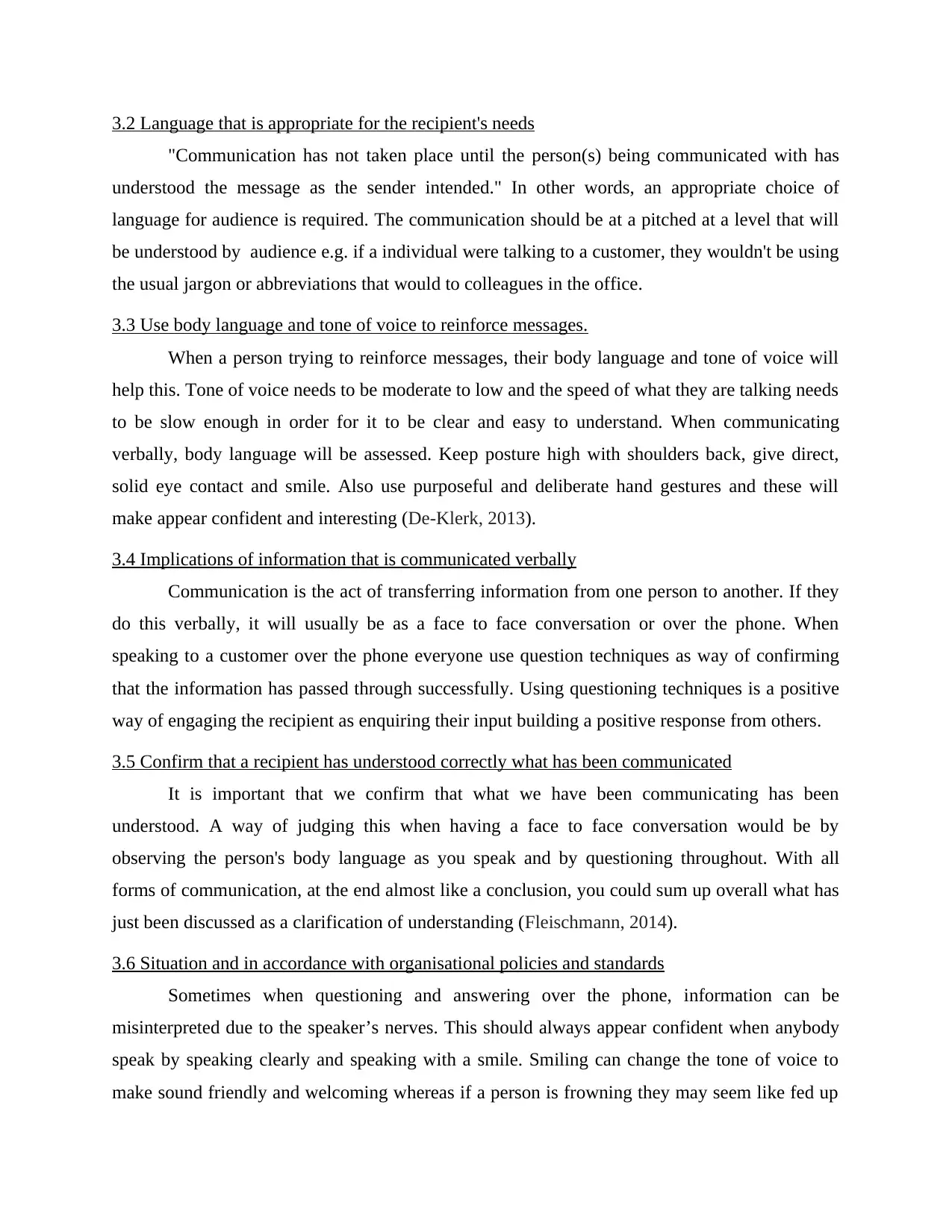
3.2 Language that is appropriate for the recipient's needs
"Communication has not taken place until the person(s) being communicated with has
understood the message as the sender intended." In other words, an appropriate choice of
language for audience is required. The communication should be at a pitched at a level that will
be understood by audience e.g. if a individual were talking to a customer, they wouldn't be using
the usual jargon or abbreviations that would to colleagues in the office.
3.3 Use body language and tone of voice to reinforce messages.
When a person trying to reinforce messages, their body language and tone of voice will
help this. Tone of voice needs to be moderate to low and the speed of what they are talking needs
to be slow enough in order for it to be clear and easy to understand. When communicating
verbally, body language will be assessed. Keep posture high with shoulders back, give direct,
solid eye contact and smile. Also use purposeful and deliberate hand gestures and these will
make appear confident and interesting (De-Klerk, 2013).
3.4 Implications of information that is communicated verbally
Communication is the act of transferring information from one person to another. If they
do this verbally, it will usually be as a face to face conversation or over the phone. When
speaking to a customer over the phone everyone use question techniques as way of confirming
that the information has passed through successfully. Using questioning techniques is a positive
way of engaging the recipient as enquiring their input building a positive response from others.
3.5 Confirm that a recipient has understood correctly what has been communicated
It is important that we confirm that what we have been communicating has been
understood. A way of judging this when having a face to face conversation would be by
observing the person's body language as you speak and by questioning throughout. With all
forms of communication, at the end almost like a conclusion, you could sum up overall what has
just been discussed as a clarification of understanding (Fleischmann, 2014).
3.6 Situation and in accordance with organisational policies and standards
Sometimes when questioning and answering over the phone, information can be
misinterpreted due to the speaker’s nerves. This should always appear confident when anybody
speak by speaking clearly and speaking with a smile. Smiling can change the tone of voice to
make sound friendly and welcoming whereas if a person is frowning they may seem like fed up
"Communication has not taken place until the person(s) being communicated with has
understood the message as the sender intended." In other words, an appropriate choice of
language for audience is required. The communication should be at a pitched at a level that will
be understood by audience e.g. if a individual were talking to a customer, they wouldn't be using
the usual jargon or abbreviations that would to colleagues in the office.
3.3 Use body language and tone of voice to reinforce messages.
When a person trying to reinforce messages, their body language and tone of voice will
help this. Tone of voice needs to be moderate to low and the speed of what they are talking needs
to be slow enough in order for it to be clear and easy to understand. When communicating
verbally, body language will be assessed. Keep posture high with shoulders back, give direct,
solid eye contact and smile. Also use purposeful and deliberate hand gestures and these will
make appear confident and interesting (De-Klerk, 2013).
3.4 Implications of information that is communicated verbally
Communication is the act of transferring information from one person to another. If they
do this verbally, it will usually be as a face to face conversation or over the phone. When
speaking to a customer over the phone everyone use question techniques as way of confirming
that the information has passed through successfully. Using questioning techniques is a positive
way of engaging the recipient as enquiring their input building a positive response from others.
3.5 Confirm that a recipient has understood correctly what has been communicated
It is important that we confirm that what we have been communicating has been
understood. A way of judging this when having a face to face conversation would be by
observing the person's body language as you speak and by questioning throughout. With all
forms of communication, at the end almost like a conclusion, you could sum up overall what has
just been discussed as a clarification of understanding (Fleischmann, 2014).
3.6 Situation and in accordance with organisational policies and standards
Sometimes when questioning and answering over the phone, information can be
misinterpreted due to the speaker’s nerves. This should always appear confident when anybody
speak by speaking clearly and speaking with a smile. Smiling can change the tone of voice to
make sound friendly and welcoming whereas if a person is frowning they may seem like fed up
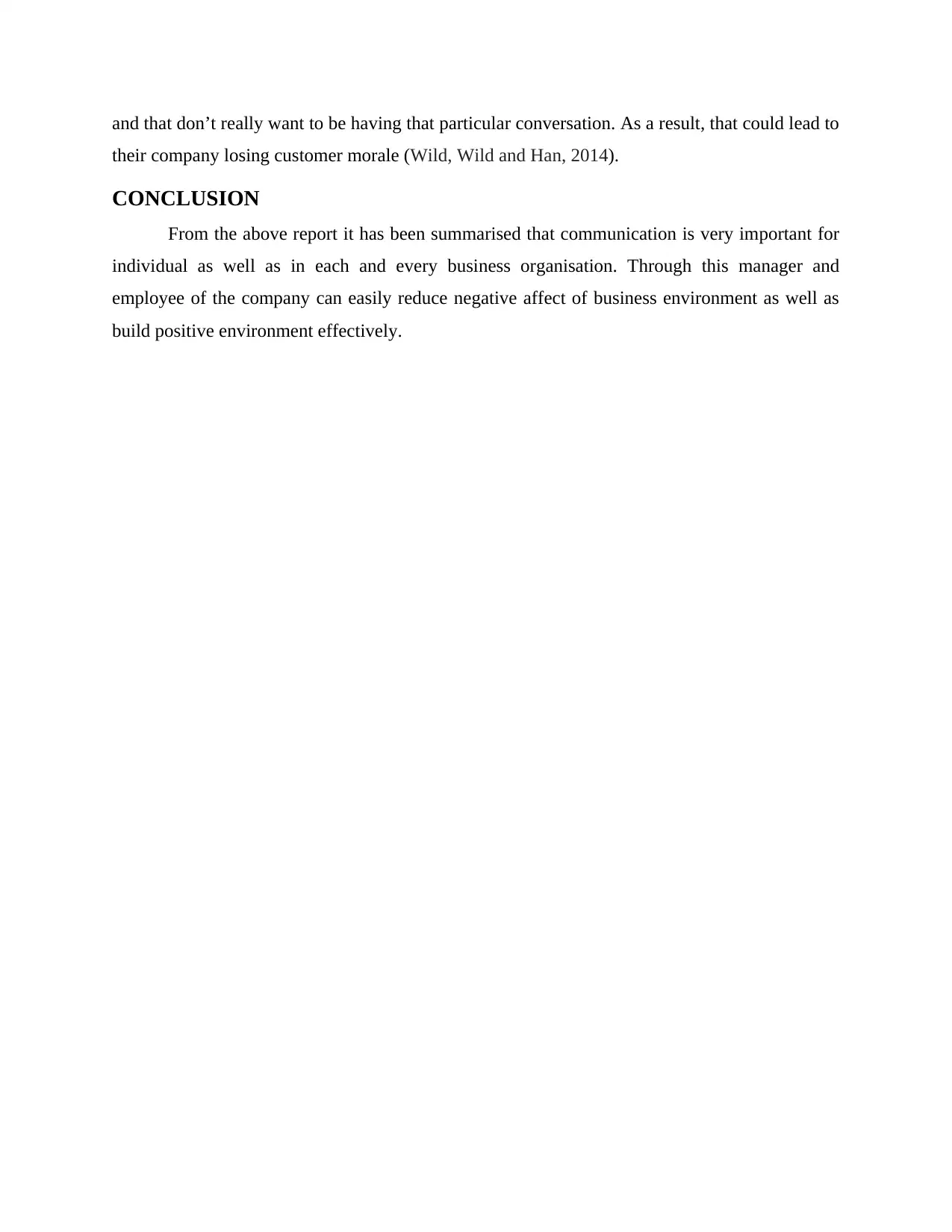
and that don’t really want to be having that particular conversation. As a result, that could lead to
their company losing customer morale (Wild, Wild and Han, 2014).
CONCLUSION
From the above report it has been summarised that communication is very important for
individual as well as in each and every business organisation. Through this manager and
employee of the company can easily reduce negative affect of business environment as well as
build positive environment effectively.
their company losing customer morale (Wild, Wild and Han, 2014).
CONCLUSION
From the above report it has been summarised that communication is very important for
individual as well as in each and every business organisation. Through this manager and
employee of the company can easily reduce negative affect of business environment as well as
build positive environment effectively.
⊘ This is a preview!⊘
Do you want full access?
Subscribe today to unlock all pages.

Trusted by 1+ million students worldwide
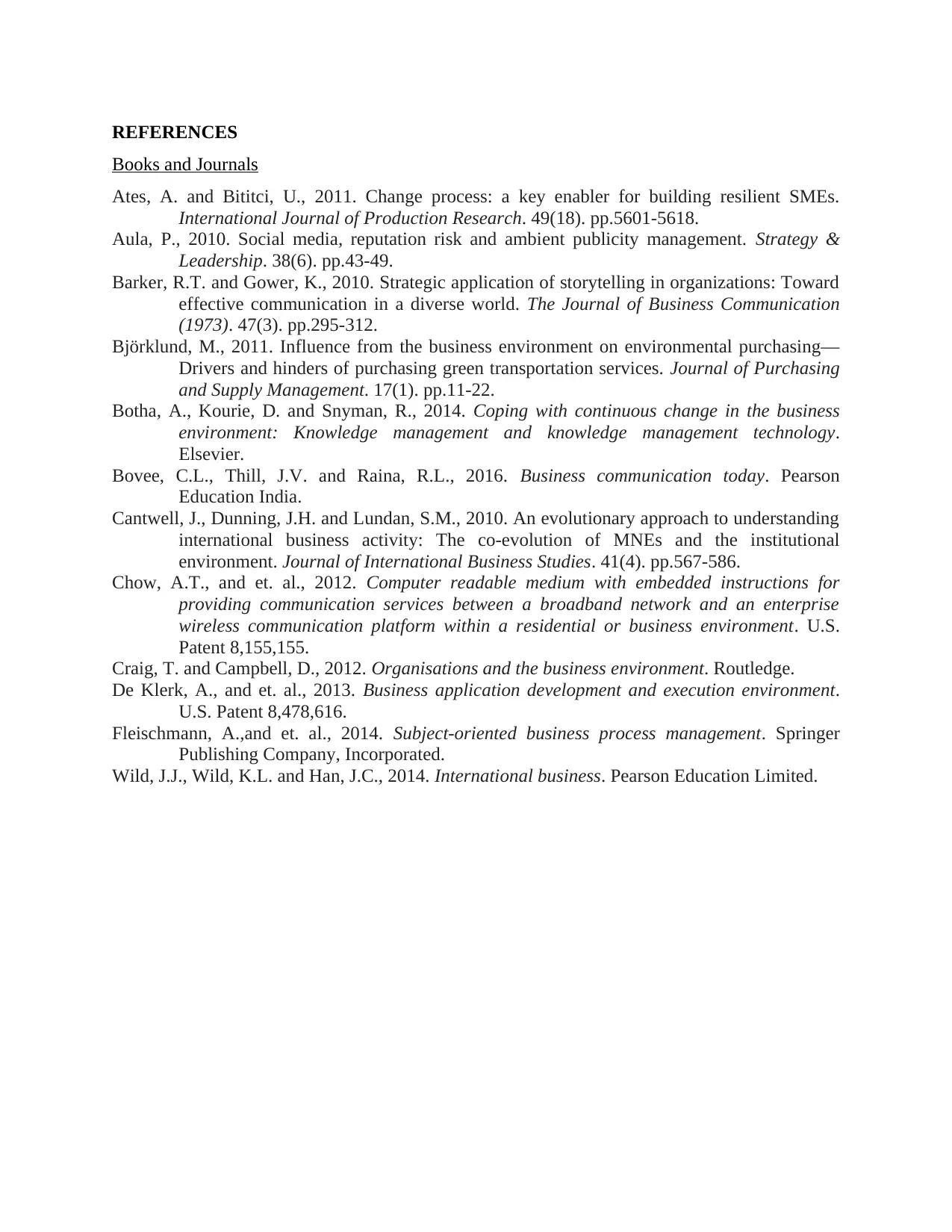
REFERENCES
Books and Journals
Ates, A. and Bititci, U., 2011. Change process: a key enabler for building resilient SMEs.
International Journal of Production Research. 49(18). pp.5601-5618.
Aula, P., 2010. Social media, reputation risk and ambient publicity management. Strategy &
Leadership. 38(6). pp.43-49.
Barker, R.T. and Gower, K., 2010. Strategic application of storytelling in organizations: Toward
effective communication in a diverse world. The Journal of Business Communication
(1973). 47(3). pp.295-312.
Björklund, M., 2011. Influence from the business environment on environmental purchasing—
Drivers and hinders of purchasing green transportation services. Journal of Purchasing
and Supply Management. 17(1). pp.11-22.
Botha, A., Kourie, D. and Snyman, R., 2014. Coping with continuous change in the business
environment: Knowledge management and knowledge management technology.
Elsevier.
Bovee, C.L., Thill, J.V. and Raina, R.L., 2016. Business communication today. Pearson
Education India.
Cantwell, J., Dunning, J.H. and Lundan, S.M., 2010. An evolutionary approach to understanding
international business activity: The co-evolution of MNEs and the institutional
environment. Journal of International Business Studies. 41(4). pp.567-586.
Chow, A.T., and et. al., 2012. Computer readable medium with embedded instructions for
providing communication services between a broadband network and an enterprise
wireless communication platform within a residential or business environment. U.S.
Patent 8,155,155.
Craig, T. and Campbell, D., 2012. Organisations and the business environment. Routledge.
De Klerk, A., and et. al., 2013. Business application development and execution environment.
U.S. Patent 8,478,616.
Fleischmann, A.,and et. al., 2014. Subject-oriented business process management. Springer
Publishing Company, Incorporated.
Wild, J.J., Wild, K.L. and Han, J.C., 2014. International business. Pearson Education Limited.
Books and Journals
Ates, A. and Bititci, U., 2011. Change process: a key enabler for building resilient SMEs.
International Journal of Production Research. 49(18). pp.5601-5618.
Aula, P., 2010. Social media, reputation risk and ambient publicity management. Strategy &
Leadership. 38(6). pp.43-49.
Barker, R.T. and Gower, K., 2010. Strategic application of storytelling in organizations: Toward
effective communication in a diverse world. The Journal of Business Communication
(1973). 47(3). pp.295-312.
Björklund, M., 2011. Influence from the business environment on environmental purchasing—
Drivers and hinders of purchasing green transportation services. Journal of Purchasing
and Supply Management. 17(1). pp.11-22.
Botha, A., Kourie, D. and Snyman, R., 2014. Coping with continuous change in the business
environment: Knowledge management and knowledge management technology.
Elsevier.
Bovee, C.L., Thill, J.V. and Raina, R.L., 2016. Business communication today. Pearson
Education India.
Cantwell, J., Dunning, J.H. and Lundan, S.M., 2010. An evolutionary approach to understanding
international business activity: The co-evolution of MNEs and the institutional
environment. Journal of International Business Studies. 41(4). pp.567-586.
Chow, A.T., and et. al., 2012. Computer readable medium with embedded instructions for
providing communication services between a broadband network and an enterprise
wireless communication platform within a residential or business environment. U.S.
Patent 8,155,155.
Craig, T. and Campbell, D., 2012. Organisations and the business environment. Routledge.
De Klerk, A., and et. al., 2013. Business application development and execution environment.
U.S. Patent 8,478,616.
Fleischmann, A.,and et. al., 2014. Subject-oriented business process management. Springer
Publishing Company, Incorporated.
Wild, J.J., Wild, K.L. and Han, J.C., 2014. International business. Pearson Education Limited.
1 out of 10
Related Documents
Your All-in-One AI-Powered Toolkit for Academic Success.
+13062052269
info@desklib.com
Available 24*7 on WhatsApp / Email
![[object Object]](/_next/static/media/star-bottom.7253800d.svg)
Unlock your academic potential
Copyright © 2020–2025 A2Z Services. All Rights Reserved. Developed and managed by ZUCOL.





